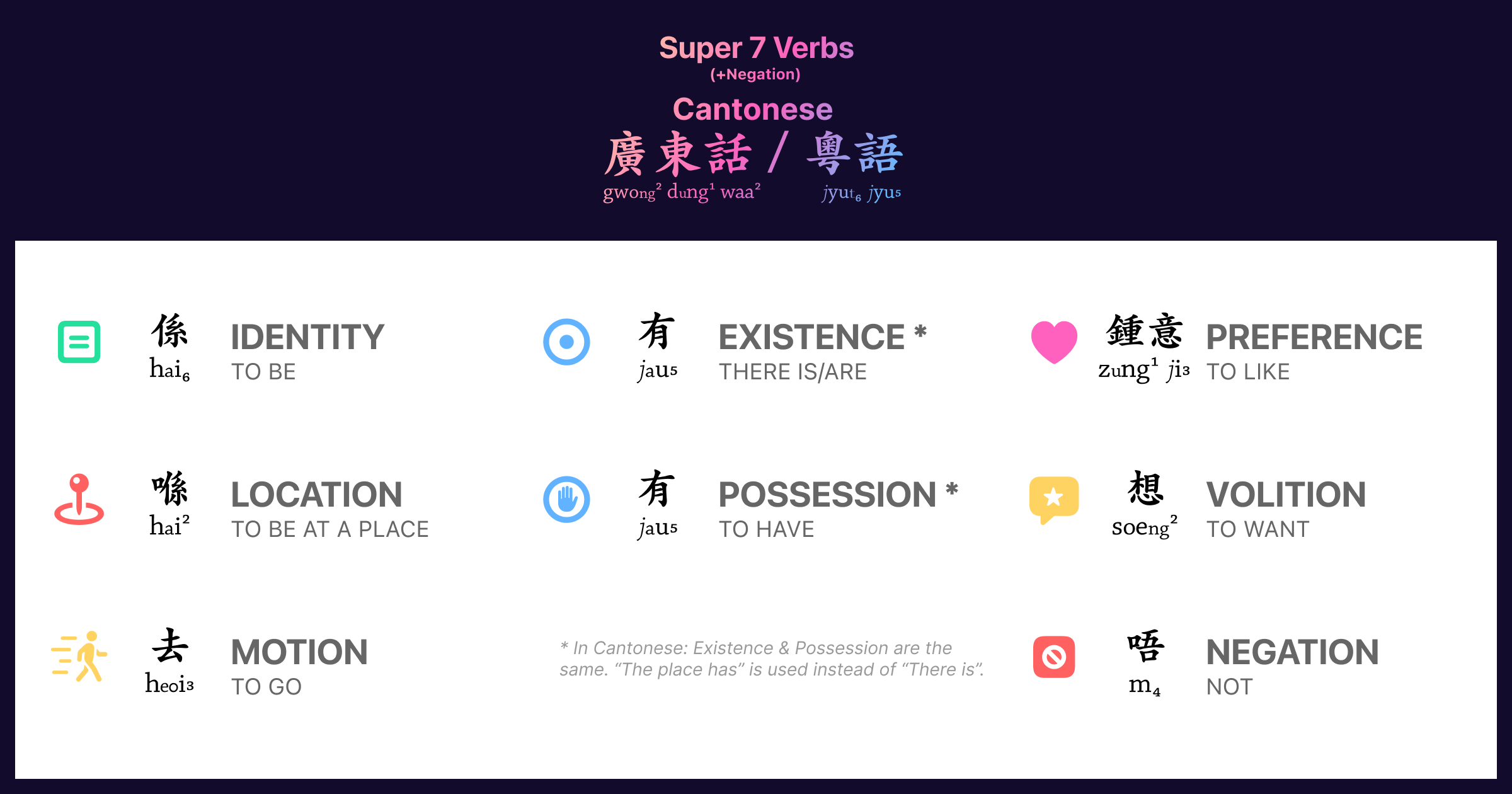In 2013, Terry Waltz identified seven words that are the most widely used in communication, in any language. These became known as the Super Seven Verbs.
The following are the Super Seven Verbs for Cantonese:

🟰 係 (hai6) – Identity: to be
- 🏕️〉 我 係 人 。 🔊 – I am a person.
- 🏕️〉 佢 係 英國 人 。 🔊 – He is British.
📍 喺 (hai2) – Location: to be at a place
- 🏕️〉 我 喺 屋企 。 🔊 – I am at home.
- 🏕️〉 我 喺 美國 。 🔊 – I am in America.
Note:
- [🟰] 係 (hai6) is a low tone
- [📍] 喺 (hai2) is a high tone
🏃♂️ 去 (heoi3) – Motion: to go
- 🏕️〉 我 去 屋企 。 🔊 – I go home.
- 🏕️〉 你 去 英國 。 🔊 – You go to England.
☉ 有 (jau5) – Existence: there is
- 🏕️〉 呢度 有 水 。 🔊 – Here, there is water.
- 🏕️〉 學校 有 學生 。 🔊 – At the school, there are students.
🎒 有 (jau5) – Possession: to have
- 🏕️〉 我 有 個 電話 。 🔊 – I have a phone.
- 🏕️〉 你 有冇 水 ? 🔊 – Do you have water?
Note:
- In Cantonese, Existence & Possession are the same. Both use 有 (jau5). Cantonese speakers describe existence as “The place has …”, as opposed to the English way of saying “There is … at the place”.
🩷 鍾意 (zung1 ji3) – Preference: to like
- 🏕️〉 我 鍾意 你 。 🔊 – I like you.
- 🏕️〉 我 唔 鍾意 蟲 。 🔊 – I do not like bugs.
🌠 想 (soeng2) – Volition: to want
- 🏕️〉 我 想 飲 水 。 🔊 – I want to drink water.
- 🏕️〉 我 想 去 澳洲 。 🔊 – I want to go to Australia.
Note: Tip: It’s easy to recognize 鍾意 (zung1 ji3) (like) and 想 (soeng2) (want), because they both have a 🏕️〉 心 🔊 (heart ❤️) in them.
Finally, here is how you negate verbs in Cantonese:
🚫 唔 (m4) – Negation: not
- 🏕️〉 佢 唔係 美國人 。 🔊 – He is not American.
- 🏕️〉 我 唔 想 食飯 。 🔊 – I do not want to eat rice.
Wrapping Up
There you have it! The Super 7 Verbs for Cantonese!
- 🟰 係 (hai6)
- 📍 喺 (hai2)
- 🏃♂️ 去 (heoi3)
- 🎒 有 (jau5)
- 🩷 鍾意 (zung1 ji3)
- 🌠 想 (soeng2)
- 🚫 唔 (m4)
With just these seven words (technically 6 verbs and an adverb), you can now understand a large amount of Cantonese sentences!
